Book contents
- Frontmatter
- 1 The violin and bow – origins and development
- 2 The physics of the violin
- 3 The violinists of the Baroque and Classical periods
- 4 The nineteenth-century bravura tradition
- 5 The twentieth century
- 6 The fundamentals of violin playing and teaching
- 7 Technique and performing practice
- 8 Aspects of contemporary technique (with comments about Cage, Feldman, Scelsi and Babbitt)
- 9 The concerto
- 10 The sonata
- 11 Other solo repertory
- 12 The violin as ensemble instrument
- 13 The pedagogical literature
- 14 The violin – instrument of four continents
- 15 The violin in jazz
- Appendix Principal violin treatises
- Glossary of technical terms
- Notes
- Select bibliography
- Index
14 - The violin – instrument of four continents
Published online by Cambridge University Press: 28 September 2011
- Frontmatter
- 1 The violin and bow – origins and development
- 2 The physics of the violin
- 3 The violinists of the Baroque and Classical periods
- 4 The nineteenth-century bravura tradition
- 5 The twentieth century
- 6 The fundamentals of violin playing and teaching
- 7 Technique and performing practice
- 8 Aspects of contemporary technique (with comments about Cage, Feldman, Scelsi and Babbitt)
- 9 The concerto
- 10 The sonata
- 11 Other solo repertory
- 12 The violin as ensemble instrument
- 13 The pedagogical literature
- 14 The violin – instrument of four continents
- 15 The violin in jazz
- Appendix Principal violin treatises
- Glossary of technical terms
- Notes
- Select bibliography
- Index
Summary
No other musical instrument has until recent years been so widely used among all classes throughout the world as the violin. One reason, of course, is quite simply the musical perfection of the instrument – its sonority and flexibility in the hands of musicians anywhere, especially, with its capacity for clean and strongly rhythmic articulation and its penetrating tone, its suitability for the performance of dance music of all styles. At the time of its invention dance musicians throughout Europe were playing a variety of bowed string instruments from the gue (probably a type of rectangular box zither) in Britain's northernmost islands, to the rebec-like lira of Greece. Such musicians, professional and amateur, looked favourably on the newcomer: first, they must have found the violin an improvement on their own instruments and, for the most part, they could readily transfer their bowing and fingering techniques to the violin. Secondly, there must have been some status attached to an instrument which found favour in courts and homes of the wealthy, even though in those milieux the violinist was often considered to be a professional musician of rather low rank.
Outside Europe the adoption of the violin can further be seen as an index to the expansion of European influence over the centuries. Wherever they went colonists and traders took violins with them and, as often as not, encouraged indigenous musicians to learn to make and play them. Because we know that professional violinists were seen as low-class providers of dance music compared with the more genteel amateur players of the viol family, we are not surprised to learn, for example, that the early white settlers in North America preferred to teach their musically talented black slaves to play the violin for them so that they themselves were spared the task and were free to indulge in what became at times a passion for social dancing.
- Type
- Chapter
- Information
- The Cambridge Companion to the Violin , pp. 234 - 248Publisher: Cambridge University PressPrint publication year: 1992
- 1
- Cited by



